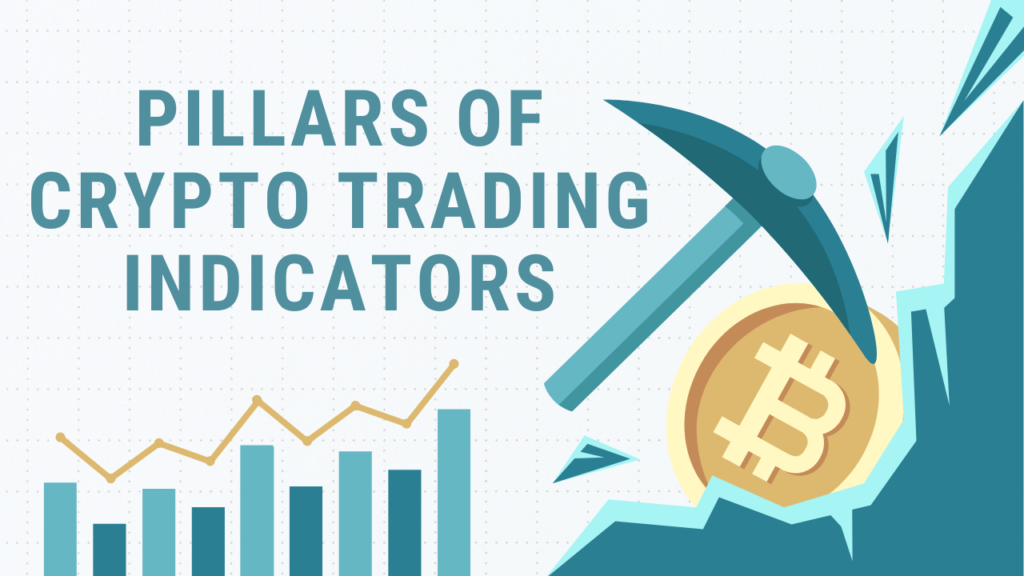Being ahead of the curve in the ever-changing world of cryptocurrency trading requires not only vigilance but also mastery of the tools available. As a guiding light in the dark waters of the digital currency markets, trading indicators are one of the most useful of these tools. To help both experienced traders and eager newcomers make better decisions, this article dives deep into the Best Indicators for Crypto Trading and reveals the best indicators for successful navigation through the volatile crypto landscape.
Pillars of Crypto Trading Indicators

Crypto Trading Momentum Indicators
If you want to know how fast and strong a cryptocurrency price is going to go, you need momentum indicators. By providing information about whether trends will continue or reverse, they act as a guide through the unpredictable crypto markets.
Relative Strength Index (RSI)
An essential tool for crypto traders, the Relative Strength Index (RSI) shows when a cryptocurrency is about to be overbought or oversold. Potential reversal points can be better identified by traders using this tool, which measures the magnitude of recent price changes. But its efficacy is subtle, and it takes a sharp eye to spot misleading signals in volatile markets.
Stochastic Oscillator
This indicator helps to identify when a cryptocurrency asset is overbought or oversold by comparing its closing price to its price range over a given period. Although traders may encounter conflicting signals from time to time during market consolidation phases, its strength is in its reversal signaling capabilities.
Moving Average Convergence Divergence (MACD)
The MACD is a powerful momentum indicator that follows trends and shows how the price of a cryptocurrency is related to two moving averages. Although it is great for identifying changes in momentum and reversals of trend, it can be slow to respond in markets that are changing quickly, so it needs other indicators to work at their best.
On-Balance Volume (OBV)
One-Band Volume (OBV) is a novel momentum indicator that correlates volume flow with price changes. An essential tool for traders seeking to match their strategies with market dynamics, it confirms trend directions and spots reversals by comparing volume to price changes.
Cryptocurrency Trend Analysis Tools

Trading successfully requires an understanding of the nature and magnitude of market trends. With the help of trend analysis tools, one can see into the heart of the market and find ways out of the mayhem.
Ichimoku Cloud
Complex yet comprehensive, the Ichimoku Cloud provides a multifaceted view of the market, encompassing support/resistance levels, trend direction, and momentum. Although there is a steep learning curve for beginners, the layered insights are invaluable.
Bollinger Bands
Market volatility and trend strength can be dynamically viewed through these bands. They aid in detecting possible breakout points and overbought/oversold situations by framing price movement with upper and lower bands. Utilizing additional indicators enhances their effectiveness, providing more discernible signals amidst market fluctuations.
Aroon Indicator
Lesser-known but powerful, the Aroon indicator sheds light on trend changes and strength by measuring the time between highs and lows. It’s a lighthouse for seeing emerging trends, giving traders a head start when planning their strategies.
Fibonacci Retracement
Fibonacci Retracement, which has its foundation in the golden ratios, is a precise tool for determining possible levels of support and resistance. In order to fully capitalize on its potential in the face of the market’s ups and downs, its application necessitates a more artistic than scientific approach.
Volume Analysis in Cryptocurrency Trading
Volume provides a snapshot of market sentiment at the macro level and is a measure of the conviction driving price movements.
Crypto Trading Volume Indicators
Indicators of trading volume are like a finger on the market’s pulse; they show you how strongly prices are moving. Buying pressure is high when volume is high and prices are rising, and selling pressure is high when volume is low and prices are falling. Traders rely on these indicators heavily because of how useful they are for validating trends and possible reversals.
Crypto Market Sentiment Indicators
It is just as important to understand the sentiment of market players as it is to study price trends and movements. If you want to know what the crypto market is thinking right now, you can look no further than sentiment indicators, which reveal insights into how traders are feeling and what could happen next.
Fear and Greed Index
To measure the emotional temperature of the market, a popular sentiment gauge called the Fear and Greed Index compiles data from a variety of sources, such as market momentum, volatility, social media trends, and more. Traders can use extremes of greed and fear to their advantage when deciding when to enter and exit the market.
Social Media Analysis
Social media sentiment has a significant impact on cryptocurrency markets. Early signals of shifts in market sentiment can be provided by tools that analyze cryptocurrency-related trends, hashtags, and mentions on platforms like Reddit and Twitter. These tools have the potential to predict sudden movements in the market.
Net Flow of Exchange Funds
One way to gauge investor mood is to keep an eye on the net inflow and outflow of funds from exchanges. A net inflow might mean that investors are getting ready to sell, which would be a sign of negative sentiment, while a net outflow could mean that investors are buying, which would be a sign of positive sentiment.
Cryptocurrency Volatility Indicators
The world of cryptocurrency is very unpredictable, which can be both a blessing and a curse. Traders can make sense of this unpredictability with the help of volatility indicators, which show when prices are likely to fluctuate a lot and present opportunities to profit.
Average True Range (ATR)
By determining the extent to which prices fluctuate over a specified time frame, the ATR gauges market volatility. While it does not dictate where prices will go, it does help traders anticipate potential future price movements for cryptocurrencies, which is useful for establishing reasonable levels of stop-loss and take-profit.
Volatility Index (VIX)
While traditionally used in stock markets, the concept of a Volatility Index, or VIX, has found its application in the crypto space as well. It provides insights into market sentiment and possible price movements by measuring the market’s expectation of volatility based on options pricing.
Historical Volatility
To provide a quantitative picture of historical volatility, this indicator determines the standard deviation of price movements over a given time frame. If the historical volatility of a cryptocurrency asset is high, it means that it has been very active recently and may continue to be so, whereas low volatility indicates that the market is in a calmer phase.
Support and Resistance Indicators Crypto
Cryptocurrency traders can greatly benefit from being able to predict when price levels will likely face support or resistance at specific levels. You can use these levels as a guide to enter and exit the market, and they can also help you forecast which way prices will go.
Trend Lines
Connecting numerous price points on a chart to form a trend line creates a support or resistance line. Indicating both continuation and reversal patterns, their simplicity belies their utility; traders can use the price’s reaction to these lines to identify potential entry and exit points.
Pivot Points
To find possible levels of support and resistance for the current period, pivot points are determined by calculating the high, low, and close prices from the previous period. To predict short-term market movements and pinpoint reversal points, day traders frequently employ them.
Fibonacci Levels
Fibonacci levels aren’t just for retracement; they can be important areas of support and resistance as well. When making trade decisions in trending or ranging markets, traders pay attention to price reactions at these levels because they typically signify substantial market interest.
FAQs
What is the best indicator for crypto trading?
There’s no one-size-fits-all answer; successful traders often use a combination of indicators like RSI, MACD, and Bollinger Bands, tailored to their trading strategy.
Can these indicators predict the crypto market accurately?
While indicators can provide insights and help forecast potential market movements, no tool can predict the market with 100% accuracy due to its inherent volatility and unpredictability.
Is it necessary to use multiple indicators?
Yes, using multiple indicators can provide a more comprehensive view of the market, helping to confirm signals and reduce the likelihood of false positives.
How important is volume in crypto trading?
Volume is a crucial indicator of the strength behind price movements. High volume during a price increase suggests strong buyer interest, making it an important factor in trading decisions.
Are sentiment indicators reliable?
Sentiment indicators can provide valuable insights into market psychology, but they should be used in conjunction with other technical and fundamental analysis tools for the best results.
Also Read: What Is APY In Crypto? All You Need to Know
Conclusion
In conclusion, there is a plethora of indicators available in the cryptocurrency trading landscape, each with its own set of benefits and peculiarities. Crypto markets can be navigated with more confidence and precision by traders who understand and use these tools. Best Indicators for Crypto Trading can significantly aid in making informed decisions and capturing profitable opportunities. If you want to be a successful trader, you can’t rely on just one indicator; rather, you need to use a combination of indicators, along with experience and ongoing education.

Timothy Jensen is an expert writer who specializes in the world of cryptocurrencies, including blockchain technology and Bitcoin. He has a passion for explaining complex topics in an easy-to-understand way. Timothy’s work aims to demystify the digital currency landscape for his readers.

